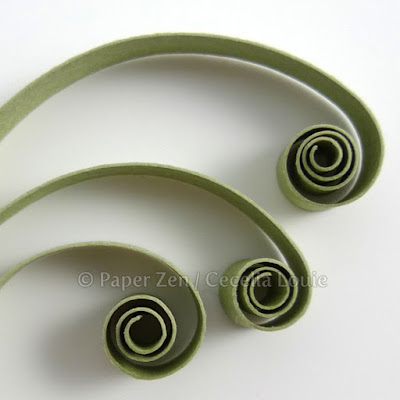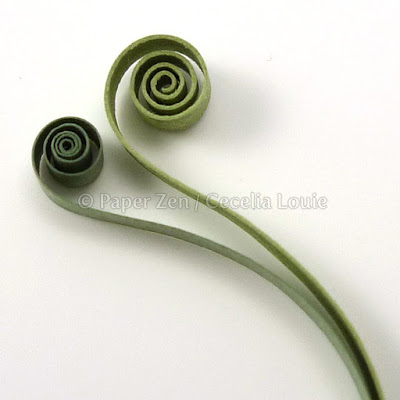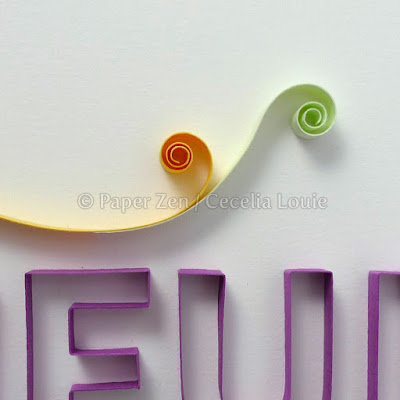I'm often asked about paper, so here's a post that goes into the paper I used for this typography project. I do buy standard quilling paper online, but since buying my digital die cutter (a Silhouette SD first, and now a Cricut Explore Air), I prefer to cut my own for projects with larger arcs and more open areas.
For my first sans serif type project, I decided to use a thicker paper like Canson Mi-Tientes, which is 160 gsm, cut to 1/4" wide. I wanted the thicker paper to hold up better with the open letters and long arcs I planned to be making. This project is much larger than the greeting cards I typically do.
When I do cut the strips, I leave the ends intact on one side, and end up with a comb-like shape. You can download my free DIY quilling strip patterns, for both hand and machine cutting here. I like a comb shape because it keeps all the strips orderly and tidy. They are never fighting in my storage containers.
I also like the Mi-Tientes color selection because there are many shades between them. I wish constantly for more, but I'm at the mercy of my local fine art stores and what they carry. I will lay them all out like this photo and assess if they "go" together. I knew I wanted a bold color like the #507 Violet for the letters to be seen easily, and felt the greens, yellows, and oranges were a good complement.
I usually use the Kemper Tool (meant for pottery) because of the tight coils it makes. However, with the thicker Mi-Tientes paper, it requires more effort to coil. I liked the results of using a thick sewing needle, but it was tiring my hands, since it had no handle. So I ended up using a crochet hook.
Here is a better close up of all three coils.
Here is a better contrast between the coils made with a needle tool vs a crochet hook. Can you see the miniature kinks in the smaller coil? This is the tension I dislike when trying to force the smaller coil on the thicker paper. It's not a big deal, really, and I prefer the smaller coil look overall, but my fingers tell me what they want to do.
Here is a comparison between standard quilling paper (left) and the Mi-Tientes (right), both coiled with my Kemper quilling needle tool. As you can see, the thicker paper can't be forced to be much smaller – I actually tried re-making it a couple times so that my innermost coil could be super tiny (and that's why it looks a bit different from the first few photos).
Another tip for using Mi-Tientes paper is to tear the ends. The green here joins nicely with the yellow because of the taper, where I tore the end.
Here is a close up of the tear from the side.
Here is another example of subtle joining, where the middle green strip nicely disappears.
In contrast, this is what it looks like if you don't tear.
Why didn't I tear these ends? Um, well, you know how those temperamental artist types are... I was really in the flow. I'll live.
After trying to photograph my word, I realize cutting the strips 1/4" was a tad thick. It casts deeper shadows than I prefer. Next time, I'll cut them 1/8" instead.
I hope this helps you with your own quilling, no matter what paper or tool you choose to use. Please let me know if this impacts your own projects by leaving a comment on my blog!












Thanks as always for sharing your work and ideas!
ReplyDeleteHey Monica, great to hear you're getting inspiration from this post!
DeleteCecelia
I've wondered about using the silhouette to cut some paper. I'll have to give it a try.
ReplyDeleteThanks.
Hey Stacy, so good to see you here. It's so good to use up every scrap of paper, cutting them for quilling. Let me know how it goes for you.
DeleteCecelia
Thank you so much for your tutorials. I've read them all and found them invaluable. They have been the most informative I've come across so far and have really helped. :-D
ReplyDeleteHello Marsky Mac, I'm so glad you found my quilling letters tutorial to be helpful! I'd love to hear or see your work some day!
DeleteCecelia
Thank you, thank you, thank you!!!! I was wondering why I couldn't get my quilled corners and not so subtle joining to look right! Tear it! You are the best thank you so much! You have no idea how much this really helps me. I mean it seems like such a simple thing, but that alone makes a world of difference on any piece. Thank you so much. I can't say it enough LOL. You have taken me to a whole new level. Lots of Love~
ReplyDeleteHello Destini, I'm very happy to hear my posts helped you in your quilling! I'm also glad that the tiny details I care about are ones that other care about too. I'd love to see your work some day! Happy quilling - Cecelia
DeleteThis is from a while back, but how did you make the foam core holder for paper? Did you just make the box from cut pieces of foam, and then use more cut pieces glued to make the different sections? I'm new to quilling and just trying to figure out the good ideas I see online.
ReplyDeleteHello Saulė P, thanks for asking about my foam core holder. Yes, I made the box to fit my strips and then fit into my drawer, because I couldn't find a ready-made box that was right for both. You guessed right - each panel of the box was made specifically to maximize my drawer and quilling strips. There was very little room so it had to be JUST right.
DeleteCecelia
Beautiful! Wonderful diy project for paper quilling.
ReplyDeleteI see why the tearing works better, and this might sound silly, but how do you tear the paper? Holding each side between thumb and forefinger and twisting in opposite directions, like opening a jump ring? Holding the strip to be torn tight to the work surface and pulling with the opposite hand like pulling off a post-it note? Once I get into the craft room and experiment I'm sure I'll find a solution but right now my cognitive impaired brain is having trouble visualizing it.
ReplyDeleteI tend to tear paper via the first method you described. However, I have also torn Canson Mi-Teintes paper by putting it on my table and placing a metal ruler on it, then tearing a good straight line. I hope you've also stumbled on my YouTube videos to watch some tutorials in action.
DeleteCecelia